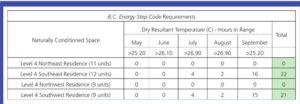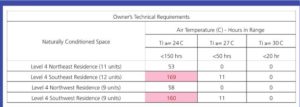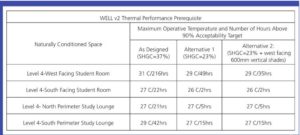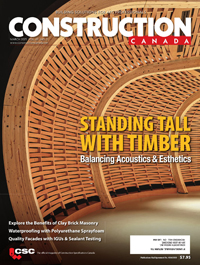Designing thermally comfortable buildings
B.C. Energy Step Code 2018
Interior dry bulb temperatures of occupied spaces shall not exceed the 80 per cent acceptability limit for naturally conditioned spaces, per ASHRAE 55-2010, for more than 200 hours per year for any zone.
Owner’s technical requirements
Naturally conditioned space shall be designed to satisfy the following criteria through passive design practices and shall be verified using thermal modelling simulation:
- internal temperature ≥ 24 C (75 F) shall not exceed 150 occupied hours;
- internal temperature ≥ 27 C (81 F) shall not exceed 50 occupied hours; and
- internal temperature ≥ 30 C (86) shall not exceed 20 occupied hours.
Operable windows and 15 per cent additional supply air capacity to account for extreme temperature events shall be provided.
WELL v2
- T01 Thermal Performance (Prerequisite): 80 per cent acceptability limit; and
- T02 Enhanced Thermal Performance (three points): 90 per cent acceptability limit.
Energy modelling overview

As with any building simulation, thermal modelling results are only as accurate as the representation of the building being constructed. Building geometry was setup in the virtual environment according to the architect’s floor plans and elevation drawings. Building zones were setup with representative internal gains and envelope constructions. HVAC systems were included corresponding to the mechanical designs. Since this building was to be naturally ventilated, it was also important to assign opening types and properties for all windows and doors in the model. Natural ventilation was simulated by having operable openings that opened when outside air was able to helpfully regulate the temperature within each space.
Once the virtual building had been constructed such that it reflected the design, thermal comfort analysis was performed to identify if each occupied space met design targets. In this summary, only results from level 4 of the building are highlighted.
Results

The B.C. Energy Step Code requires each building space to not exceed the 80 per cent acceptability limit for more than 200 hours per year, as stipulated by ASHRAE 55. Each space was, therefore, modelled to determine how many hours each month the operative temperature exceeded the acceptability limit. Since the total yearly hours for each zone did not exceed 200 hours, it was concluded the building would not overheat by the B.C. Energy Step Code standards, and therefore met the requirements. Results are shown in Figure 2.
The following analysis performed on the building involved evaluating the building’s thermal comfort with respect to the owner’s technical requirements. It was found the proposed design, which contained no mechanical cooling and 0.007 m3/s (15 cfm) of outside air per person, did not meet the owner’s requirements. Both south-facing student residence zones exceeded 24 C for more than 150 hours a year, as seen in Figure 3.
The results indicated mechanical cooling would be required in student residences to meet specified thermal comfort requirements. As an alternative to full cooling, ‘partial’ cooling based on cooling of ventilation air was assessed. It was found providing partial cooling at 18.3 C (65 F) through the ventilation system and increasing outdoor air to 0.02 m3/s (50 cfm) per person would be sufficient to meet the owner’s thermal comfort requirements.
With these strategies, however, the building did not meet the WELL v2 Enhanced Thermal Performance credit. Following WELL v2 requirements, overheating occurred in south- and west-facing student rooms, and both north and south study lounges.
Analysis was performed to determine if passive strategies could be used to reduce the maximum operative temperature and the hours each room was above the 90 per cent acceptability target. Strategies to reduce solar gain included using windows with a lower SHGC and installing vertical shading on the west façade of the building. The results from this study can be seen in Figure 4.

Both strategies yielded significant improvements in both the peak operative temperature and number of hours above the 90 per cent acceptability limit, meeting the WELL v2 credit for Enhanced Thermal Performance. To further exemplify the effect of reducing SHGCs, Figure 5 illustrates the difference in solar gain in the level 4 lounge with an SHGC of 0.37 compared to an SHGC of 0.23.
These design changes had an immense effect on the solar gain in the level 4 lounge, yet it likely would not have been considered had there not been a thermal comfort model. Reducing the SHGC of the windows and implementing exterior fixed shading, coupled with operable windows, increased outdoor airflow, and partial cooling resulted in a building that met thermal comfort requirements and limited building energy use.
Strategies

This project is an example of a building that did not meet thermal comfort requirements with the initial building design, but was able to achieve targets by identifying areas needing improvement and applying both passive and mechanical strategies to reduce heat gain where overheating was found to be an issue. Many strategies can be used to achieve thermal comfort, including but not limited to the following:
- passively cooling the building
- building shape and massing
- building orientation
- thermal mass
- window design
- cool roof (e.g. green roof)
- shading to block solar heat gains
- exterior fixed and operable window shades
- vegetation (e.g. trees)
- glazing with low-emissivity (low-e) coatings reduced SHGCs
- electrochromic glazing
- natural ventilation – operable windows and doors
- cooling with ventilation air – increased outside airflow when outdoor air can provide free cooling
- mechanical cooling
- heat pumps
- variable refrigerant flow (VRF)
- tempering of ventilation air (partial cooling)


